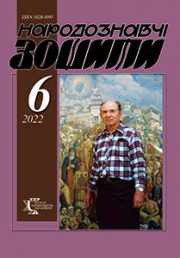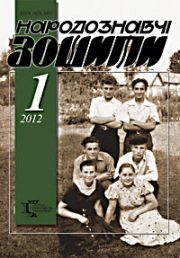The Ethnology Notebooks. 2020. № 1 (151), 49—59
UDK745.52:677.074.54/58(477)”1921/1991″:659.127.6
DOI https://doi.org/10.15407/nz2020.01.049
UKRAINIAN INDUSTRIAL CARPETMAKING AS A BRAND IN THE SOVIET SYSTEM OF ARTS AND CRAFTS
YAMBORKO Olha
ORCID ID: https://orcid.org/0000-0003-0340-5436
Candidate of Sciences in Art Studies,
Associate Professor of the department of design and theory of art,
teacher of Institute of arts of the Prykarpattya national university
of the name of Vasyl Stefanyk.
57, Shevchenko str., 76000, Ivano-Frankivsk, Ukraine,
Contacts: e-mail: kalyna015@gmail.com
Abstract. Introduction. In the Soviet period, Ukrainian industrial carpetmaking reached the level of a national brand that reflected a distinctive cultural tradition and produced a peculiar — recognizable markets model of products, created in accordance with the aesthetic requirements of its time.
Problem Statement. In the article we will try to analyze the aspects that testify to the Ukrainian industrial carpet as a national brand. In this sense, the Ukrainian carpet industry was not considered in the past, since the concept of «brand» was not practiced in the Soviet economics.
Purpose. The objective of the proposed article is the industrial carpet of sub-Soviet Ukraine, its factors and grounds, and the subject is the features of development in the conditions of the Soviet planned economics and the formation of this production as a national brand.
Methods. The work uses historical, comparative, stylistic-typological and structural methods of research.
Results. The original features of industrial carpetmakingin Soviet Ukraine are revealed. The artistic range of production of Ukrainian carpet centers, the source of style, the aspects of standardization of methods of carpet production are shown.
Conclusion. Ukrainian industrial carpetmakingin the Soviet period retained and developed its identity, which contained an artistic and stylistic concept based on the tradition of regional branches of carpets and had certain parameters: typological (flat-wovengeometric and floral carpets, pile lizhnyks), quality standards and the original nomenclature.
Such a model was actively asserted during the 1940s—1980s. Being in the system of folk artscrafts, the Ukrainian carpetmaking of the Soviet period was developed solely on the basis of its tradition. An attempt in the 1950s to establish here the production of pile rugs by the technology of the Caucasian and Central Asian republics was provisional and ineffective.Therefore, in the context of the Soviet industry, the Ukrainian carpetmaking belonged to the branches of production with an original — autochthonous character. Taken together, these features make allows us to consider the Ukrainian industrial carpetmaking of the the Soviet period as a national brand.
Keywords: Ukrainian industrial carpetmaking, Soviet industry, national brand.
Received 3.01.2020
REFERENCES
Zhuk, A. (1973). Ukrainian Soviet carpet. Kyiv: Naukova dumka [in Ukrainian].
Zakharchuk-Chuhaj, R.V. (Ed.). (1986). Folk Art Crafts of the USSR: Handbook. Kyiv: Naukova dumka [in Ukrainian].
Levin, L., Leoshkevich, I., & Saruhanov, S. (1975). Artistic carpets of the USSR. Moskva: Jekonomika [in Russian].
Carpets and rugs are Ukrainian. General specifications. (1997). DSTU ISO 1982-97 from 27th June 1997. Kyiv: Derzhstandart Ukraine [in Ukrainian].
Parfenchuk, I. (2017). Brand-oriented management of enterprise competitiveness in the national economy. (PhD). Ivan Honchar Dnipropetrovsk national university [in Ukrainian].
Kurban, O. (2014). Brand in the system of modern social communications. Information Society, 19, 56—58 [in Ukrainian].
Bulhakova, O. (2017). Brand image of the enterprise in the consumer market. Uzhgorod National University Scientific Bulletin: Series International Economic Relations and the World Economy (Issue 13, vol. 1, pp. 31—36) [in Ukrainian].
Yamborko, O. (2018). Carpets and rugs in housing interior as element of the soviet life culture. The Ethnology notebooks, 53 (143), 1149—1160 [in Ukrainian].
Kovrigina, V. (1982). The Institute’s activities in the field of economics of folk arts and crafts. Folk arts and crafts: Theory and practice (Pp. 58 — 68). Moskva [in Russian].
Sezeva, N. (2010). Plots and ornamental motifs of the Tyumen folk carpet. Altai State University Bulletin, 2, 157—161 [in Russian].
Zhuk, A. (1985). Regional stylistic features of the Ukrainian carpet. Arts: theory and practice. Scientific works (Pp. 22—35). Kyiv: Naukova dumka [in Ukrainian].
Sydorenko, H. (1959). Carpets of Poltava region. Folk art and ethnography, 1, 105—109 [in Ukrainian]
Zhuk, A. (1979). Ukrainian carpet. Fine Arts, 2, 19—22 [in Ukrainia].
Laschuk, Yu. (1992). Folk art of Ukrainian Polissya. L’viv: Kameniar [in Ukrainian].
Dobrians’ka, O., & Zapasko, Ya. (1956). Carpet weaving of the «Peremoha» Artel in the village Hlyniany, Lviv region. Materials of ethnography and crafts, (Issue II, pp. 21—31). Kyiv [in Ukrainian].
Tsurkan, K. (2019). Art education in the field of textiles in the Lviv region of the second half of the 19th — early 21st centuries (history, structure, artistic and methodological features. (PhD). Lviv National Academy of Arts [in Ukrainian].
Khamula, M. (1969). Hlyniany — is the city of my carpets. New York: Literaturno-movna redaktsiia Leonida Poltavy [in Ukrainian].






